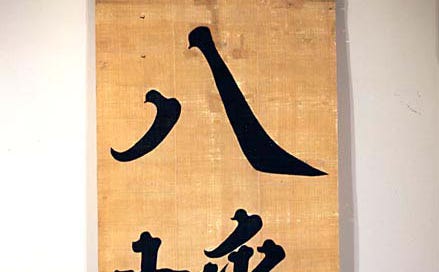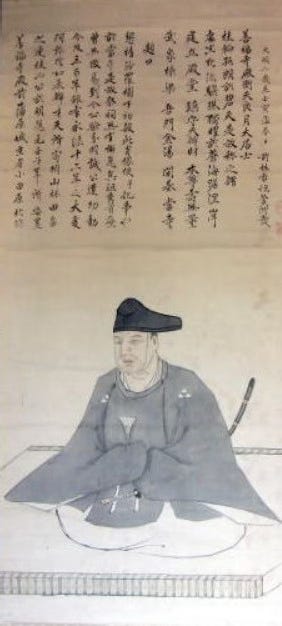Hojo Tsunashige (also known as Hojo Tsunanari) was one of the bravest and most able generals of the Hojo clan of Odawara.
As a military commander, Tsunashige was known for his valor, and it is said that on the 15th of each month he would purify himself and pray to the God of War, Hachiman Daibosatsu for victory in battle. As the vanguard of the Hojo army, his name is said to have spread far and wide. Tsunashige was also the commander of Tamanawa Castle in Kamakura and Kawagoe Castle, Saitama Prefecture.
Early Years - The Controversy
Tsunashige was born in 1515. His early life contains much that is questionable.
His father is said to have been the Imagawa clan retainer, commander Fukushima Masanari. There are two theories about the circumstances of his father’s death: one is that he was killed in action in the Battle of Iida-gawara. In the spring of 1521 Totomi (now Shizuoka Prefecture) based Imagawa Ujichika led an invasion into Takeda held territories, with Fukushima Masanari as commander-in-chief. The 8,000 Imagawa troops marched north along the road beside the Fuji River before joining up with the allied Anayama troops and began preparations to attack the Takeda’s Tsutsujigasaki Castle.
The Takeda forces led by vassal Hara Toratane and having just 2,000 troops, had dammed the Arakawa River upstream to make it appear as if the river was shallow and safe, and once the Imagawa army had crossed, they destroyed the levee, trapping the Imagawa. As a result, Imagawa commander Fukushima Masanari was said killed, along with most of the Imagawa army.
Another theory is that in 1536, Tsunashige’s father, Fukushima Masanari was killed for supporting Imagawa Yoshimoto's elder half-brother, Genko Etan in the Hanakura Rebellion, an internal conflict within the Imagawa Clan.
But was Fukushima Masashige really Tsunenari's father? Indeed, did Fukushima Masanari even really exist? Numerous historians, including premier historian Professor Owada Tetsuo claim that the name Fukushima Kazusa no Suke Masashige does not appear in any Imagawa historical records or documents. Apparently, there was a Fukushima Saemonnojo Sukeharu who was killed in the Battle of Iida-gawara, and that considering the power of the Fukushima clan in the Imagawa clan’s internal Hanakura Rebellion, it is difficult to imagine that his child would have been left an orphan after the Battle of Iida-gawara.
Tsuneshige’s real father may have been Kushima Masashige Kuro, a warrior killed in the Battle of Shirakohara in 1525. Kushima Kuro Masashige is thought to have been of the Fukushima clan, and a vassal of the Imagawa.
Either way, after his father's death, the young Tsunashige is said to have fled to Odawara accompanied by his retainers where he received protection from warlord Hojo Ujitsuna, (1487 –1541) the son of Hojo Soun, and the founder of the Go-Hojo clan.
Tsunashige becomes Tsunanari
Hojo Ujitsuna became very close to Tsunashige and was most impressed by the young man, so much so, he married his daughter to him and welcomed him into the Hojo clan awarding him honour of the surname, Hojo. Tsunashige’s name is said to have changed to Tsunanari around this time, the name is said to be a combination of Ujitsuna's first name (the character "tsuna") and his father Masanari's "nari"….if indeed that was his father’s name. Tsunarari was later appointed guardian of Ujitsuna's son, Hojo Tamemasa, and when Tamemasa died in 1542, Tsunashige — now Tsunanari — is said to have formally become Tamemasa's adopted son and as such, was made the third lord of Tamanawa Castle. However, this adoption story has been contested by several historians, claiming that there was no such adoption, and that although Tsunanari was in a position to perform memorial services for Tamemasa, after 1566 he handed that position over to Hojo Ujitsuna’s son, the third lord of the Odawara Hojo clan, Hojo Ujiyasu.
As Hojo Ujiyasu was the same age as his brother-in-law, and trusted Tsunanari (Tsunashige) completely, to the degree that Tsunanari was sometimes given full authority in diplomatic and military affairs as Ujiyasu's representative.
Hojo Tsunanari In Action
In battle, Hojo Tsunanari was known to have carried an approximately two-meter-high flag made of silk dyed “the colour of withered leaves”, with the character Hachiman, for the God of War stencilled on it. Known as the Jihaku Hachiman banner, it is currently on display at the Sanada Treasure Museum in Matsushiro, Nagano Prefecture. This was apparently left behind when the Takeda and Hojo clans were at odds, and Tsunanari, who was defending Suruga Fukazawa Castle, surrendered it to Takeda Shingen’s and returned to Odawara in 1571. Shingen is said to have given it to Sanada Genjiro Nobutada, the son of his vassal Sanada Yukitaka, in hopes that he could emulate Tsunanari's bravery.
His military skills and bravery shone especially in field battles, where he was said to have always taken the lead on the front lines, despite being the commander in chief, charging forward shouting "We’re winning! We’re winning!" encouraging his troops. His bravery put fear into the Uesugi and Takeda enemy.
The Hojo faced the Uesugi clan in 1537 and by this stage, Tsunanari was in charge of the Hojo Goshiki Sonoethe elite Yellow Banner corps.
In particular, during the night battle of Kawagoe in 1546, (see the full article here: https://samuraihistoryculture.substack.com/p/the-battle-of-kawagoe-castle-and) Hojo Tsunanari endured an over half year siege, then marched out in unison with the main army to break through the enemy, making a major contribution to the Hojo forces’ comeback victory. This fine achievement is said to have been the reason for him being made the lord of Kawagoe Castle. He continued to play an active role as one of the most able generals in the Hojo clan, leading his troops well in the 1551 Siege of Hirai Castle against Uesugi Norimasa.He saw further action in the Third Battle of Kawanakajima (Battle of Uenohara) in 1557, when he led reinforcements for the Takeda advancing as far as Ueda, forcing Uesugi Kenshin’s troops to retreat, and in the Battle of Kokunodai against Satomi Yoshihiro and Ota Sukemasa, where he led a surprise attack force, crushing the Satomi forces. He saw front line action in the First Siege of Odawara against Uesugi Kenshin in 1561 and three years later in 1564, fought in the Second Battle of Konodai against Satomi Yoshihiro.
In 1567, the Hojo faced the Satake clan in the Battle of Numajiri where 20,000 samurai under Satake Yoshishige fought against 80,000 Hojo troops. The Satake were victorious, due in part to their use of over 8,600 matchlock guns.
According to the Takeda clan’s Koyo Gunkan, in the Battle of Misumasu Pass against Takeda Shingen on October 6, 1569, Tsunanari's musketeers killed Asari Nobutane, the Takeda force’s left-wing commander. He also fought the Takeda at the Battle of Fukazawa Castle in Suruga (Gotemba City, Shizuoka Prefecture) in 1571.
In 1570 Hojo Ujiyasu and Ujimasa attacked and captured Fukasawa Castle with a large army of 38,000 men, and appointed Hojo Tsunanari as the castle's commander. Later that year, a large Takeda army surrounded the castle and sent Tsunanari a demand to surrender via a letter attached to an arrow. Tsunanari refused to capitulate, so the Takeda mobilized their gold miners to dig tunnels and destroy the castle walls. On the verge of collapse Tsunanari then handed the castle over to the Takeda and retreated to Tamanawa Castle.
Shortly after this, Hojo Ujiyasu died of illness in October 1571, Tsunanari passed over the family headship to his son Ujishige, retired, shaved his head, and took the name Kazusa Nyudo Dokan. Hojo Tsunanari died of illness on June 11, 1587, aged 73. His grave is at Ryuhoji Temple in Tamanawa.






